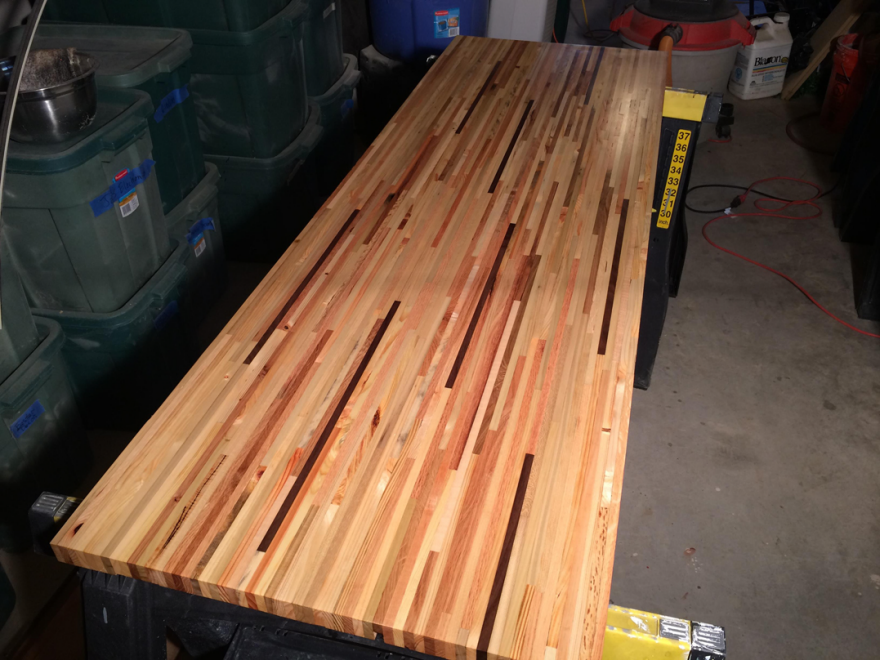
Beautiful, Potentially Short-Lived Tabletop Made from Pallet Wood
While it seems to be the darling of Facebook-friendly DIY furniture roundups, there are lots of reasons not to use pallet wood in your projects. Chief among these is that a subset of pallets have been fumigated with toxic pesticides by their manufacturers, making the material a poor choice for cutting boards, baby cribs and dining tables. But perhaps the biggest reason not to use the stuff is simply that it's a royal pain in the ass to "harvest" and machine into something usable.
A good case in point is this beautiful tabletop made by this fellow. While he and his girlfriend managed to skip the torturous nail-pulling step by simply cutting around them…
 Enter a caption (optional)
Enter a caption (optional)…he still had a boatload of work to do to get usable strips for his tabletop project:
 Enter a caption (optional)
Enter a caption (optional) Enter a caption (optional)
Enter a caption (optional) Enter a caption (optional)
Enter a caption (optional) Enter a caption (optional)
Enter a caption (optional) Enter a caption (optional)
Enter a caption (optional) Enter a caption (optional)
Enter a caption (optional)You can read details on what he had to go through here.
Unfortunately, I suspect the tabletop won't last long due to wood movement. I'm no expert at wood identification, but in this shot…
 Enter a caption (optional)
Enter a caption (optional)…I see what looks to be cedar, southern yellow pine and poplar. The reason different woods are not often mixed in cutting boards, tabletops and the like is that they will expand and contract at different rates as the seasons change, eventually leading to joint failure.
Still, I think the results are beautiful and that the project was a worthy undertaking, both to develop skills and as a learning experience. And the anonymous builder has a good eye; I like the way he isolated and alternated the darker- and lighter-colored strips.
-
o2Favorite This
-
Q12Comment
K
{Welcome
Create a Core77 Account
Already have an account? Sign In
By creating a Core77 account you confirm that you accept the Terms of Use
K
Reset Password
Please enter your email and we will send an email to reset your password.


Comments
How is the table holding up?! That table looks amazing!! I'm in the middle of building one just like this. The pic above is the first dry-fit to see how it looks. If you have any tips, please share!
I doubt that inter-species wood movement will have much difference given the narrow thicknesses and the length of the long grain glue joints.
reinforcing the joints with screws across the board would eliminate the possibility entirely. Laminated table tops like this often are more likely not to warp due to the varied orientations of individual pieces. It is more akin to plywood. The species you mention are actually quite similar in tangential expansion.
Cracks
and checks would more likely be to to defects in the wood, varied
moisture contents, reaction woods, and inclusions of pith and unbroken
annual rings as a result of using low grade quickly processed timbers
that are used in pallets.
to avoid breakdowns and moves the slats are glued and traversed by threaded rods
Sasha, glues and mechanical fastening cannot stop or contain wood movement. If the wood is not allowed to move, it will eventually crack. If you are the one who built this, do let us know how it turns out in 6 months or a years' time. I do wonder if, as Alex pointed out below, the pieces are thin enough that the movement will be negligible.
para evitar averías y mueve los listones se pegan y atravesados por varillas roscadas
A slightly more upscale version of pallet reuse can be found in Toronto:
http://therefinedpallet.ca/
Mike.
The cross section of the individual pieces is fairly small, so the wood movement is also likely to be small regardless of species. A bigger impact is related to whether or not the underside of the table was finished with polyurethane. Both sides need to be finished or the moisture effect will be unbalanced and the table will cup.
Awww! A little Volxie!
Also, that isn't meant to be snarky. I realise the tone sounds rather harsh, but I'm not at all mad. Just pointing out what these folks might be thinking.
Two things: First, making use of a pallet, which would otherwise end up in a scrapheap, is a good move toward upcycling. Better to use it for *something* than to just toss it aside. Second, some people have more time than money. For college students or other scrappy youngsters, a pile of pallets represents hundreds saved in purchasing hardwood. Sure, it might not be the longest-lasting furniture, but the idea of buying black walnut to build a slapdash coffee table is laughable.
The pesticide issue is more than just concern with food contact- if you're sanding pallet wood, you're likely breathing some godawful stuff. You're not saving hundreds either, pallets are most often made of the worst quality softwoods money can buy. Even as a starving student (who's unlikely to have the tools anyway), you're far better off just buying cheap wood, or at least upcycling better material- alley find furniture, construction debris, etc.